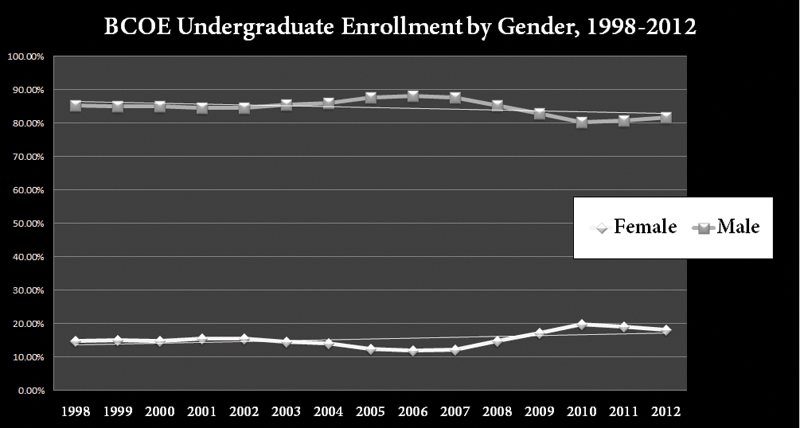
After a few strolls in Bourns and Winston Chung Halls, through dim hallways of male-dominated work space, one discovers the status quo in which female students hardly participate in engineering classes. In this case, observations are not far from the truth. According to the Bourns College of Engineering website, only 18 percent of currently-enrolled undergraduates are women.
However, this inequity is not exclusive to UCR. Data from the U.S. Bureau of Labor shows that female engineers hold the smallest percentage, at 20 percent, of all Science, Technology, Engineering and Mathematics (STEM) occupations in the United States. From a local and national standpoint, women are simply underrepresented in engineering.
Programs such as the Society of Women Engineers and BCOE’s STEM Outreach at UCR recognize this ongoing gender gap and strive to help females consider engineering fields at an elementary-level age. Although these invitations have potential in contributing to the gradual increase of females enrolled for and employed in engineering fields, underlying issues remain that prevent society at large from viewing women as engineers.
The unequal ratio of men to women in engineering careers clearly shows that the notion of a female engineer is not completely accepted. According to the Gender and Education Association, many subjects are socially categorized as either “masculine” or “feminine.” STEM subjects — such as physics and calculus — are strongly tied to masculinity, even more than humanities subjects are tied to femininity.
Popular sitcom “The Big Bang Theory,” for example, features three male physicists with Ph.D.s and one aerospace engineer with a master’s in engineering. They interact with a attractive blonde waitress named Penny, whose comedic contributions to the dialogue are based on her lack of knowledge in science. Networks continue to juxtapose juvenile and materialistic women with technical, intelligent men. Growing girls throughout the United States may not consider science and math careers, as television reminds us that those fields belong to men.
A recent study published in “American Sociological Review” correlates lack of confidence with the lack of female engineers. Erin Cech, who researched the topic at Stanford University, revealed that female engineering students were equally, sometimes more, successful than men academically. However, the women in the study did not see themselves as future professional engineers as much as men did. The cause, she states, is “very subtle differences in the way that men and women are treated in engineering programs and from cultural ideologies about what it means to be a competent engineer.” As of now, most mainstream fictional media portrays a world of sciences in which men rule.
Currently, women make up about half of the College of Natural and Agricultural Sciences at UCR. We also see women in science fields other than engineering every day. For example, a young girl may be inspired to pursue a biology degree when seeing a female doctor.
Meanwhile, women’s success in the engineering field as a whole goes unexposed. Whether an engineer spends time in an office or conducts field work, their jobs are typically hidden from the public eye. In fact, a study supported by the National Science Foundation found that “more females than males took advanced biology (50 percent versus 39 percent), while males took physics at higher rates than females (42 percent versus 36 percent).” Females’ lack of interest in engineering-based subjects (physics and calculus) was linked to “a lack of female role models” and “girls being unaware of what engineers do.”
If primetime television can’t give us a strong, female engineer, where else do we look? In the United States, fewer than 300,000 females are employed as engineers. It would be logistically impossible to have female engineers visit every elementary school in the nation — but on the other hand, new episodes of “The Big Bang Theory” reach up to 19 million viewers. If popular media would stray from embracing old gender stereotypes, perhaps women in engineering would be more commonly acknowledged.
Many programs, such as the the National Girls Collaborative Project have taken the initiative to advocate engineering to K-12 girls, but percentages continue to trend at extremely negative rates. Until women can be encouraged to pursue careers in engineering, not only in these programs, but on mainstream television and throughout all educational institutions, it is difficult to expect a sudden closure in the gender gap.








